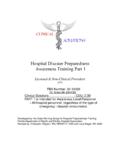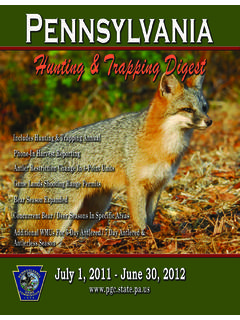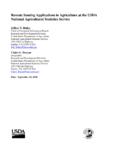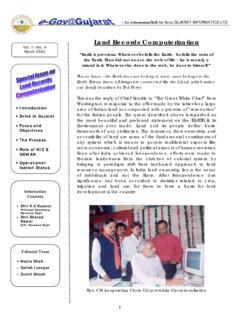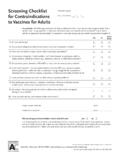Transcription of Use of MSMA for Weed Management in Turf
1 W 243. Use of msma for weed Management in turf Brosnan, Associate Professor, Department of Plant Sciences, University of Tennessee Breeden, Extension Specialist, Department of Plant Sciences, University of Tennessee Introduction Current Status of msma use for Turfgrass weed Management Monosodium methanearsonate ( msma ) is a commonly used herbicide in warm-season climates. On Sept. 30, 2009, the EPA announced a decision Since the 1960s, this product has been used to regarding the use of msma for agricultural weed manage infestations of various crabgrass species Management . Impacts on the turfgrass industry (Digitaria spp.), as well as goosegrass (Eleusine were significant, with repercussions that will indica) and dallisgrass (Paspalum dilatatum) in change weed control strategies. warm-season turf . msma , an organic arsenical herbicide, contains an organic form of the element Residential turf , Commercial turf and Sports turf arsenic.
2 In its organic form, arsenic is relatively Maintenance nontoxic. For example, the herbicide msma is far less toxic than aspirin. , However, in an inorganic Distributors of msma products labeled for use on state, arsenic can be highly toxic. It is important to residential lawns, commercial lawns and sports turf note that msma only contains organic arsenic. were prohibited from selling the products to end- Furthermore, research has continually shown that users after Dec. 31, 2010. Existing stocks of msma . msma is tightly bound to soil organic matter and is could be used legally for weed control in these not readily leached. areas until exhausted, provided that these uses comply with the EPA-approved label and labeling However, water samples from two golf courses in of the affected product until Dec. 31, 2013.
3 Beyond Florida tested high in arsenic in 2006. This spurred this date, all applications of msma for lawn care a ruling by the Environmental Protection (both residential and commercial) and athletic field Agency (EPA) to cancel the registration of msma Management are now prohibited. in all aspects of agriculture, including turfgrass Management . There was a concern that organic Other uses that fall under these restrictions include arsenic from msma could convert into the more forestry, nonbearing fruit and nuts, citrus (bearing toxic, inorganic form in the environment. and nonbearing), seed production (bluegrass, fescue and ryegrass), drainage ditch banks, Multiple public comment periods followed the railroad, pipeline, utility rights-of-way, fence rows ruling, and the response from various facets of and storage yards.
4 Agriculture was overwhelming. The msma task force, an alliance of chemical companies that Golf Courses manufacture the product, and the cotton industry formulated a response. Concerns were raised on The EPA announcement of 2009 laid out amended a number of issues about the ruling, particularly use directions for applying msma to golf course that no information was provided regarding the turf . Newly constructed courses are allowed one type of arsenic detected in the water ( , organic broadcast application, while existing courses can or inorganic), the source of the arsenic found, and use msma only as a spot treatment. Spots must that there was no way to conclusively say that the be less than 100 square feet and no more than 25. arsenic was from applications of msma . percent of the course can be treated within a given year.
5 These restrictions were made effective on Sept. 30, 2009, and are in place until a National 1. Cultural practices Academy of Sciences review on risks associated with inorganic arsenic exposure is final. This The best defense against any weed invasion review was slated to begin in 2013 and is expected is a healthy, dense, vigorous turf stand. to take nearly 41 months to complete. Results of Implementing cultural practices (aerification, the review are essential in determining the future fertility, mowing, etc.) to maximize turf status of msma as a turfgrass herbicide. density will make fields less susceptible to weed encroachment. For example, goosegrass To that end, msma can be used on golf courses thrives in compacted, poorly drained soils. according to the amended use directions of Soils of this nature are commonly found in 2009 until a ruling on this review has been high-traffic areas on sports fields where there made public.
6 For more information on the status is minimal turfgrass cover. Improving soil of the ruling, visit the Organic Arsenical Product conditions in these areas through aerification Task Force website: and topdressing will reduce the likelihood of a goosegrass infestation. Sod Farms 2. Use the product while it is still available The 2009 EPA announcement also developed amended directions for the use of msma on sod turf managers dealing with infestations of farms. To that end, sod farms can be treated with annual grassy weeds should use msma while two broadcast applications of msma per season, it is still legal to do so. Make a diligent effort and a 25-foot buffer strip is required for farms to control these weeds now and then shift bordering permanent water bodies. the focus to preemergence control of annual Similar to golf courses, msma can be used on sod grassy weeds.
7 This point especially rings farms according to these amended use directions true for dallisgrass (Paspalum dilatatum), as until the National Academy of Sciences review of there are few economical options other than inorganic arsenic is complete. msma for selective postemergence control of dallisgrass in turf . Highway Rights-of-Way 3. Effective preemergence practices The use of msma for weed Management along highway rights-of-way is similar to sod farms. The loss of an effective, economical According to the 2009 EPA announcement, two postemergence herbicide like msma renders broadcast applications of msma are allowed per preemergence control of annual grassy weeds year, and a 100-foot buffer strip will be required more important than ever. When applied when spraying near permanent water bodies. Use correctly, preemergence herbicides containing can continue in this manner along highway rights- active ingredients such as prodiamine (trade of-way until the National Academy of Sciences' name: Barricade), oxadiazon (trade name: review of inorganic arsenic is complete.)
8 Ronstar), dithiopyr (trade name: Dimension), indaziflam (trade name: Specticle) and Dealing with the restrictions pendimethalin (trade name: Pendulum) can provide effective control of annual grassy weeds like crabgrass and goosegrass for The loss of msma will certainly make managing extended periods of time. Other existing weeds in warm-season turf more difficult, herbicides and some new herbicides also and, inevitably, more expensive. Research is provide preemergence control of grassy continually evaluating new compounds, as well as weeds and some broadleaves. It is imperative combinations of existing compounds, that will help that these materials be applied prior to the soften the blow. To follow the latest research being germination of weed seed and are watered conducted at the University of Tennessee, visit in after application.
9 Most labels require . inch of irrigation or rainfall after application. Focusing on a few key principles may help turfgrass See publication, W 146: Crabgrass Species managers better cope with the deletion of msma Control in Turfgrass, for more information on from the turfgrass marketplace. preemergence control. 4. Use alternative postemergence herbicides References turf managers have applied msma for 1. Anonymous. 1997. Acetylsalicylic Acid postemergence control of annual grasses (Aspirin)-Material Safety Data Sheet. Available like crabgrass and goosegrass, in addition at: to perennials such as dallisgrass, purple Accessed 15 February 2009. nutsedge and yellow nutsedge. A list of other commercially available herbicides exhibiting 2. Anonymous. 2001. msma 6 Plus- Material efficacy against these weeds is presented Safety Data Sheet.
10 Available at: http://www. in Table 1. It is important to remember that Accessed 15. herbicides exhibiting some degree of efficacy February 2009. will not always result in complete control. 3. Environmental Protection Agency. 2009. The use of brand or trade names is for clarity and Pesticide Reregristration Organic Arsenicals: information and does not imply the endorsement Web page: of a product to the exclusion of others that PEST/2009/September/Day-30 may be of similar, suitable composition. It does Accessed: January 2010. not guarantee or warrant the standard of a product. This publication contains pesticide recommendations that are subject to change at any time. The recommendations in this publication are provided only as a guide. It is always the pesticide applicator's responsibility, by law, to read and follow all current label directions for the specific pesticide used.

